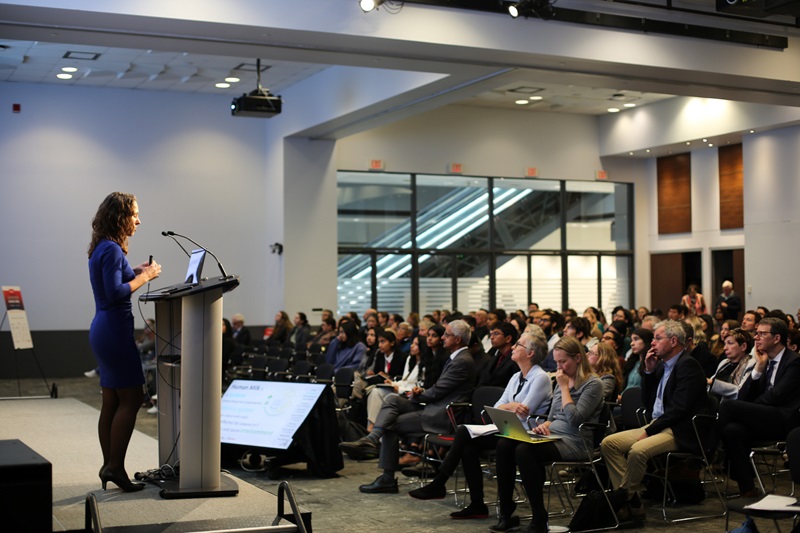David Klenerman

Professor Sir David Klenerman is the Royal Society GSK Professor of Molecular Medicine at the Yusuf Hamied Department of Chemistry, University of Cambridge. He is a physical chemist who graduated and completed his doctorate at Cambridge University working with Professor Ian Smith on infra-red chemiluminescence for his PhD in 1985. This was followed by postdoctoral research at Stanford University, California with Professor Dick Zare on high overtone chemistry. He then returned to the U.K. and worked for seven years for BP Research in their Laser Spectroscopy Group before returning to the Department of Chemistry, University of Cambridge, progressing to a Professorship. At Cambridge his work has focussed on the development and application of physical methods, particularly laser spectroscopy and single molecule fluorescence, to biological and biomedical problems. Recent work has focused on studying the molecular basis of the adaptive immune response and detection and characterization of the protein aggregates associated with neurodegenerative disease. He has identified the key molecular events in protein misfolding and the aggregation of beta amyloid, tau and alpha synuclein, and investigated how oligomers of these proteins interact with live neurons and initiate cellular damage. His recognition includes being knighted in 2018, for development of high speed DNA sequencing, and being awarded the Royal Society’s Royal Medal in 2018 and the 2020 Millennium Technology Prize, both jointly with Shankar Balasubramanian. He was also awarded the 2022 Breakthrough Prize for Life Sciences jointly with Shankar Balasubramanian and Pascal Mayer for next generation sequencing.
The Work:
Balasubramanian, Klenerman and Mayer are recognized for developing the underlying methodologies that led to Solexa-Illumina Next Generation DNA Sequencing (NGS), a technology that has enhanced our basic understanding of life, converting biosciences into ‘big science’ by enabling fast, accurate, low-cost and large-scale genome sequencing – the process of determining the complete DNA sequence of an organism.
Balasubramanian and Klenerman’s original work involved methods to observe a single molecule of DNA polymerase incorporating fluorescently labelled DNA monomers onto a growing strand of DNA hybridised to an immobilised template. They had the vision to see how this science could be extended and applied to sequencing a vast array of immobilised DNA molecules in a way that would bring huge benefits of scale, speed and cost. They co-founded the company Solexa, later acquired by Illumina, to make the technology available to the world. Mayer conceived and performed the initial development of 'DNA colony-based massively parallel sequencing by synthesis', initially at Glaxo-Wellcome’s and Serono’s research institutes in Geneva, and finally at a spin-off company, Manteia Predictive Medicine, where he was Chief Scientific Officer. This cluster technology is a key component of the Solexa-Illumina massively parallel sequencing technology. Manteia and its intellectual property were acquired in 2004 by Solexa. NGS has had – and continues to have – a transformative impact in the fields of genomics, biology and medicine. It has allowed a million-fold improvement in speed and cost when compared to the first sequencing of the human genome. In 2000, sequencing of one human genome took over 10 years and cost more than a billion dollars; today, the entire genome of multiple humans can be sequenced in a single day at a cost of less than $1,000. More than a million human genomes have been sequenced, and continue to be sequenced at scale each year, as well as genomes of animals, plants, bacteria and viruses, providing unprecedented insights into genome variation across the planet.
The Impact:
NGS has had an enormous impact on life sciences. Many aspects of the basic research into mechanisms in living systems now routinely involve high-throughput sequencing of DNA or RNA as the primary readout. Clinical research is undergoing a revolution via the application of genome sequencing, and genomic applications more generally, to discover the underlying causes and markers of diseases, along with substantial new knowledge on the genetic causes and signatures of cancers. There is a wave of new clinical diagnostics emerging for cancers, rare genetic diseases and infectious diseases enabled by NGS of patient samples that now includes minimally invasive blood sampling. During the COVID-19 pandemic, NGS was essential to the rapid understanding of the viral cause of the disease, and then in identifying and monitoring the spread of new variants. Without this technique, progress towards developing vaccines and other interventions would have been slow. It is difficult to overstate the importance and impact of NGS. It has initiated a revolution in biology, enabling the revelation of unsuspected genetic diversity in humans and their pathogens, with major implications, from cell and microbiome biology to ecology, forensics and personalized medicine.

.tmb-cfthumb_fb.png?Culture=en&sfvrsn=374218_1)





.tmb-cfthumb_fb.png?Culture=en&sfvrsn=87d51a9d_1)
